Dignity and Independence: How Grab Bars Empower People with Dementia
 Submitted by Maria Lindbergh
Submitted by Maria Lindbergh
MOT, OTR/L, ECHM
Owner
Toilet Talk
Bathrooms, often considered our personal sanctuaries, are spaces where we begin and end our days. From morning showers to nightly rituals, the bathroom plays a significant role in our daily lives.
Not to be too doom and gloom, but the bathroom can become a place of accidents and hazards, especially for people with dementia and their caregivers. This is where grab bars step in, offering valuable support and enhancing bathroom safety for everyone involved.
What Are Grab Bars?
Grab bars, sometimes referred to as safety bars or handrails, are sturdy and secure fixtures mounted into studs or wood blocking in the walls of a bathroom. These bars are strategically placed to provide support and stability for people as they navigate their daily bathroom routines.
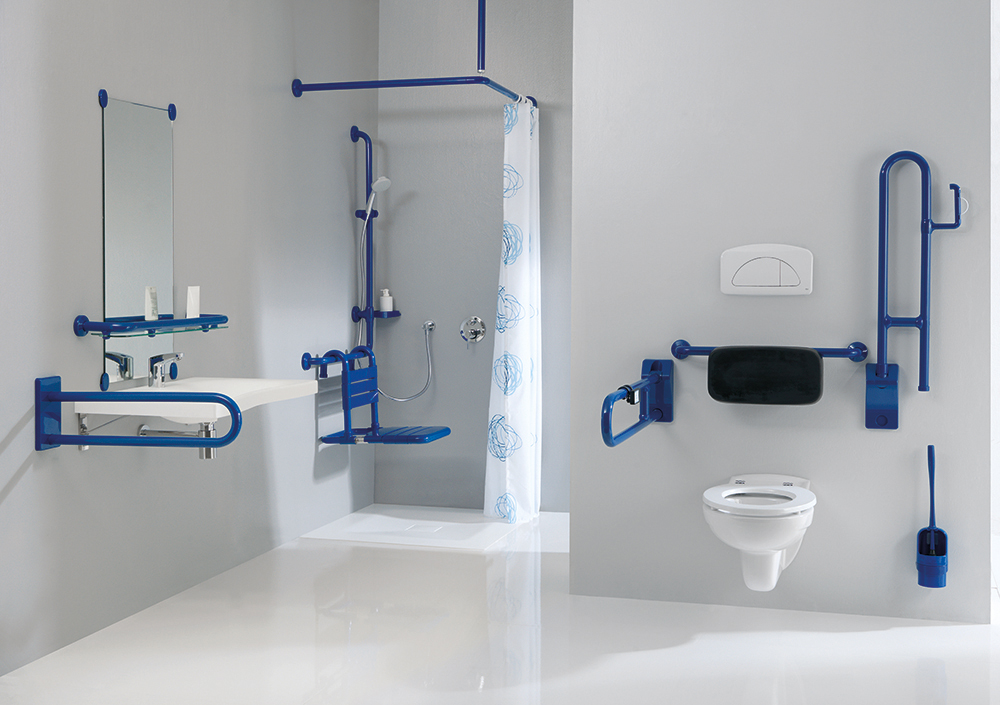
They come in various lengths, materials, and styles to suit different needs and aesthetics. For people with dementia, there are certain colors and materials that enhance their ability to do tasks in the bathroom. We’ll touch on that more in a bit.
First, let’s focus on other ways grab bars help people with dementia.
How Grab Bars Support People with Dementia
Balancing Act
One of the primary functions of grab bars is to assist individuals with balance issues. Whether it’s stepping into or out of the shower, or simply maneuvering around the bathroom, these bars provide a steady anchor to prevent slips and falls.
Independence and Dignity
For those with mobility challenges, maintaining independence and privacy is vital. Grab bars allow people to carry out personal hygiene tasks without needing assistance, preserving their dignity and self-reliance. This is incredibly important for people with dementia who may become easily agitated when a caregiver tries to help them in the bathroom.
Aging in Place
Many people with dementia and their families opt to stay in their homes for as long as possible. Grab bars play a crucial role in facilitating “aging in place” by making bathrooms more accessible, reducing the need for costly renovations, and supporting a safer living environment. It’s more affordable to live at home compared to the cost of a memory care facility.
Children and Caregivers
Grab bars are not just for seniors! People of all ages and abilities, like parents and young children, can also benefit from their use. Grab bars are ideal when multiple generations are living under one roof. Additionally, caregivers can more easily assist those with disabilities or medical conditions.
Where to Install Grab Bars for People with Dementia
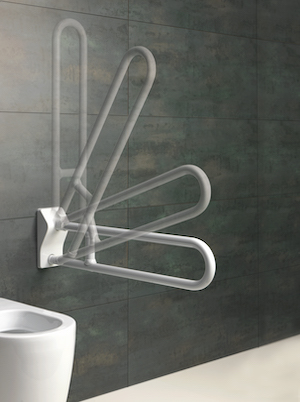
The strategic placement of grab bars is essential to ensure they serve their purpose effectively. Common locations for grab bars include:
Shower or Tub
The shower entry is your top priority for installing a grab bar because they help people enter and exit the bathing area safely. The number one place to fall at home is while you are stepping out of the shower per the Centers for Disease Control and Prevention. Consider also adding grab bars inside the shower area to provide support during bathing.
Toilet Area
Guess where the second most common place is to fall at home? Yes, the toilet! Installing grab bars near the toilet is crucial for people who have difficulty sitting down or standing up. Grab bars provide a stable handhold and leverage for managing clothing, personal hygiene, and mobility.
Sink Area
In some cases, having a grab bar near the sink can assist users in maintaining balance while standing and performing tasks like brushing teeth. Grab bars can be used to help people with dementia sit down or stand up from a seat at the sink. Sitting at the sink allows people with dementia to concentrate better during morning and evening routines.
Placement Advice with the Grab Bar Guide
Do you feel unsure on where to put a grab bar next to the toilet? Take away the guesswork by downloading the free Bold, Beautiful, and Balanced Grab Bar Guide to customize grab bar placement in four steps! In addition to the Grab Bar Guide, you’ll have access to the free Grab Bar Guide video series that demonstrates each step. As you go through the steps, the guide will recommend certain grab bar designs that work best for your needs.
If you would like guidance on where to install grab bars in your bathroom, ask for an occupational therapy referral from your family member’s primary care provider. An occupational therapist can come to your home and help you figure out the best grab bar placement for your unique situation.
Material and Style Choices for People with Dementia
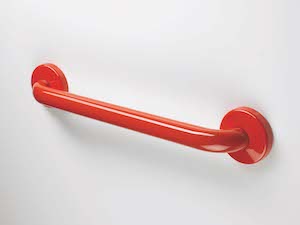
Grab bars are available in various materials, such as stainless steel, brass, or plastic, each with its unique advantages. The choice of style and finish can also complement the bathroom’s overall design, ensuring that safety doesn’t compromise aesthetics.
That’s right! People with dementia can have stylish grab bars, too!
With that being said, there are some grab bar colors and materials that help people with dementia do the things they need and want to do in the bathroom. Grab bars that are red or yellow boost alertness and attention. If you’re instructing a person with dementia to “grab the red bar”, the bright color will make it easier to find and therefore easier for that person to follow directions.
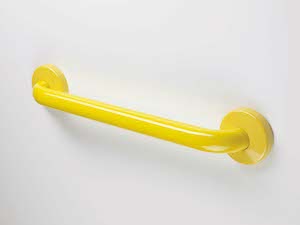
Another benefit of yellow or red grab bars is that these colors raise the perceived temperature of the room. People with dementia are usually older and more likely to feel cold while using the bathroom. Red and yellow grab bars can make them feel warmer without the need to turn up the thermostat.
If your person with dementia is regularly agitated, especially in the bathroom, consider using blue or green grab bars to give the sense of peace and calm. Studies have shown that the color green reduces central nervous system activity, which is soothing for people with dementia and enhances their ability to focus on bathroom tasks.
The best grab bar material for people with dementia are vinyl-coated grab bars. These grab bars are preferable compared to stainless steel grab bars because they feel warm to the touch. When grab bars feel good to touch, they’re more likely to be used by people with dementia when moving around in the bathroom.
Unlike stainless steel grab bars, vinyl-coated grab bars prevent wet hands from slipping. The material feels like sneakers on a gym floor. Your grip feels secure while holding onto the grab bar as you get in and out of the shower or on and off of the toilet.
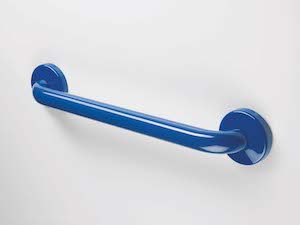 |
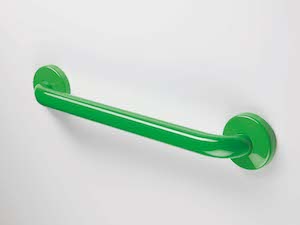 |
| Courtesy Toilet Talk | |
Did we answer your questions on how grab bars empower people with dementia?
Grab bars are unobtrusive yet invaluable additions to any bathroom, providing essential support to people with dementia and their caregivers. They enhance bathroom safety, promote independence, and facilitate aging in place.
Whether you’re looking to enhance your bathroom’s safety or help a loved one remain self-reliant, installing grab bars is a practical and considerate choice. These unassuming fixtures exemplify the idea that sometimes, it’s the small changes that make the most significant difference in our lives.
 Maria Lindbergh, MOT, OTR/L, ECHM
Maria Lindbergh, MOT, OTR/L, ECHM
Owner
Toilet Talk
Toilet Talk offers bathroom solutions, financial resources, a blog, videos, a free newsletter, and an online course, “Hard Time Wiping? Let’s Talk A-booty It!”


